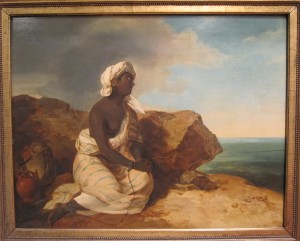(Click to Enlarge)
Oil on Wood Board
16 1/8 x 20 1/2 inches
25 x 29 1/4 inches framed (partial pictured)
Horizontal split (hand to right edge)
Signed P. Fendi middle left (above bag right of vegetable)
A rare oil painting by Austrian master Peter Fendi last sold at auction on November 9, 1935 by Albert Kende auction house, Vienna, Austria . Fendi painted African slaves in a few watercolors (one included in Peter Fendi und sein Kreis, Albumtitelblatt fur Furst Metternich, 1837 Kat. 62). The palette is similar other works and possesses the pathos qualities of other works. Other than the few watercolors, I am not aware of any large scale oil paintings in this subject matter. It is possible that this work was inspired during or after his time in Venice. Fendi went to Venice in 1821 and studied Venetian 16th century masters.
Lot 0352 from Sale Catalog D-1631
Artist Name: FENDI, PETER (Austrian)
from catalog: Peter Fendi
Title / Description “Die Negersklavin.” Voll Trauer ist sie am Strande hingesunken und blickt sehnsüchtig auf das weite Meer. Öl. Holz. Signiert. H. 40, B. 51 cm.
Genre: Genre
Object Type: Gemälde
Material / Dimensions: Öl auf Holz, 40 cm x 51 cm
Seller from catalog: Wien, I., Kärntnerring 4, I. Stock, Telephon U-46-0-48
Transaction: Schätzpreis: 1000Ausrufpreis: 500
Sale Date: 1935 Nov 08 – 1935 Nov 13 (This Lot: Nov 9)
Sale Location: Vienna, Austria
Auction House: Kende (Albert)
from catalog: Auktionshaus Albert Kende
Sale Location: Kärntnerring 4, Wien I, Vienna, Austria
Seller: from title page: [Keine]
Notes: Freiwillige Versteigerung der Kunstsammlung und vornehmen, kompletten Wohnungs-Einrichtung in Wien, I., Kärntnerring 4, I. Stock ; Versteigerung 8., 9., 10., 11, 12. und 13. November 1935 / Auktionshaus A. Kende, Wien 1935. Interieurs; Experten: Otto Fröhlich, Albert Kende (Gemälde); Leopold Wessely (Silber); Bernhard Kohn (Flügel); Artur Specht (Teppiche); Johann Illy (Pelze); Albert Kende (Kunstgewerbe, Skulptur, Graphik); Artur Reichmann (Bibliothek). Mit Schätzpreisen.
Peter Fendi, (1796 – 1842) the great watercolorist of the Viennese Biedermeier period, was born in Vienna on September 4, 1796. He was the son of Joseph Fendi, who was a schoolmaster, and his wife Elizabeth. While still a child, he demonstrated an impressive talent for drawing and at the age of thirteen entered St. Anna’s Academy of Fine Art, where he was to remain for three years. Decisive to Fendi’s career development was his encounter with Joseph Barth, who was the personal eye doctor of Joseph II and an enthusiastic art collector. Through his connections to other influential contemporaries, Fendi became an artist at the Imperial Gallery of Coins and Antiquities, which belonged to the imperial art collections. The artist occupied himself mainly with printing, etching, lithography, and wood carving. His experiments in multicolored printing are considered pioneering achievements in the field of lithography. Since art appreciation was part of what it meant to be alive during the Biedermeier period, Fendi was often summoned to noble and common residences to give instruction in drawing and painting. In choosing idyllic family motifs, Fendi became the founder of Genre-painting, which became customary during Vienna’s Biedermeier period. Fendi died on August 28, 1842. Today his works can be found in the Albertina Museum’s collection of graphic art in Vienna, in the Austrian Gallery in the Belvedere, in Vienna’s Museum of History, and in the collections of the Prince of Liechtenstein in Vaduz.




